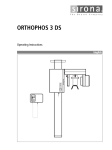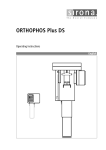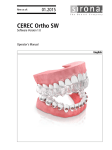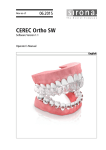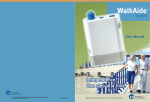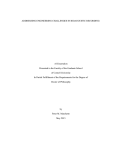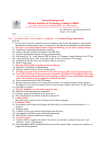Download Marus TL 500 Owner`s manual
Transcript
TL 500 Track Light Owner’s Manual Marus 11727 Fruehauf Drive Charlotte, NC 28273 USA Technical Support: 800-304-5332 FAX: 888-861-9366 Warranty All of our products sold to and installed by dealers are guaranteed to be free from defects in workmanship and materials for five years from date of purchase. Upholstery is warranted for a period of one year from the date of purchase. During that period, we will replace any defective part at no charge. We WILL NOT be responsible for dealer or service company labor charges or shipping charges to the factory. This guarantee does not cover normal wear, stains, cuts or scratches of upholstery or surface finishes or parts sold to OEM customers. Staining, discoloration or deterioration of the equipment caused by disinfectant solutions is not covered under the warranty. We will pay the return freight charges from the factory to the dealer. This guarantee does not cover damage resulting from improper installation, misuse or accidents incurred in shipping and handling. All claims against the freight carrier must be initiated at the time the damaged items are received. The claim is the responsibility of the customer. We are constantly striving to improve our products. We reserve the right to make modifications without the need for prior notification and are not obliged to modify previously manufactured items. Fiber optic system note: Units equipped with the optional fiber optic system are covered under the five year warranty, although the bulbs are items not covered under warranty and must be purchased. It is the user’s responsibility to read and understand the contents of this manual. This manual contains important information relative to hazards to personnel and property if this equipment is not installed, used and/or maintained as instructed. 11727 Fruehauf Drive Charlotte, NC 28273 USA Technical Support: 800-304-5332 FAX: 888-861-9366 92353 • Rev. 5 • 02/12 Table of Contents General Information and Warnings.......................................................................................................2 Definition of Symbols......................................................................................................................2 Product Disposal............................................................................................................................2 Interference with Electromedical Devices.......................................................................................2 Incompatible Devices and/or Accessories......................................................................................2 Obtaining Technical Literature........................................................................................................2 Safety Notes.........................................................................................................................................3 Storage Conditions.........................................................................................................................3 Technical Specifications for the Dental Light........................................................................................4 Technical Description — Light........................................................................................................4 Electrical Specifications..................................................................................................................4 Light Specifications.........................................................................................................................4 Replacement Parts for Dental Lights..............................................................................................4 Safety Markings..............................................................................................................................4 Device Classification......................................................................................................................4 Overview / Replacement Parts.............................................................................................................5 Suggested Mounting Methods..............................................................................................................6 Suggestions for Suspended Ceiling.....................................................................................................7 Mounting Parallel and Perpendicular..............................................................................................9 Electrical Requirements.....................................................................................................................10 Installation Instructions.......................................................................................................................10 Adjusting the Light-head’s Horizontal Rotation...................................................................................13 Adjusting the Light-head’s Vertical Rotation.......................................................................................13 Adjusting the Light-head’s Third Axis Rotation..................................................................................14 Focusing the Light..............................................................................................................................14 Turning the Light On and Off..............................................................................................................14 Replacing the Bulb.............................................................................................................................15 Adjusting the Auto-Switch(Optional)...................................................................................................16 Flex Arm Adjustment..........................................................................................................................16 Vertical..........................................................................................................................................16 Horizontal.....................................................................................................................................16 Cleaning the Light..............................................................................................................................17 WARNINGS, DISINFECTING & STERILIZATION - LIGHTS.......................................................17 Unacceptable Disinfectants..........................................................................................................17 Conditionally Acceptable Disinfectants*.......................................................................................17 Cleaning Reflector and Cover......................................................................................................18 Dimensions and Range of Motion - TL 500 Track Light.....................................................................19 Dimensions and Range of Motion - Light Head..................................................................................21 Service Location - Track Light Power Supply.....................................................................................21 Service Location - Light Head............................................................................................................22 Electrical Schematics.........................................................................................................................23 Electromagnetic Compatibility............................................................................................................25 Checklist.............................................................................................................................................29 1 GENERAL INFORMATION Definition of Symbols The following symbols may be used throughout this manual: CAUTION. Failure to carefully follow the described procedure may result in damage to the equipment. WARNING. Failure to carefully follow the described procedure may result in damage to the equipment and/or operator/patient injury. Risk of electrical shock present. Ensure power is disconnected before attempting this procedure. AC (Alternating Current) Protective Earth (Ground) Product Disposal Contact your local authorized dealer for proper disposal of the device to ensure compliance with your local environmental regulations. Interference with Electromedical Devices To guarantee the operational safety of electromedical devices, it is recommended that the operation of mobile radio telephones in the medical practice or hospital be prohibited. Strong EMI sources such as electro surgery units or x-ray units may affect performance. If performance problems occur, move the light to another electrical circuit or physical location. Incompatible Devices and/or Accessories For reasons of product safety, only original manufacturer devices & accessories approved for this product, or accessories from third parties which have been released by the manufacturer may be used. It is the user’s risk when using nonreleased accessories are used. Obtaining Technical Literature The manufacturer will make available on request circuit diagrams, component parts lists, descriptions, calibration instructions or other information that will assist technical personnel to repair and replace serviceable items. Manufacturing date Waste Electrical and Electronic Equipment Type B Equipment (Protected against electrical shock) Product Identification This dental light can be identified by its product label, located on product. This label states the light model and serial number, electrical specifications, manufacture date and safety classification. Note the SAMPLE labels shown below. Dangerous Voltage Marus Electrical Testing Lab Identification mark that indicates the product complies with the health & safety requirements as published by European Directives. WARNING: This product is intended for use by trained dental/medical professionals only. WARNING: This product must be disinfected before use. 2 Dental Light 11727 Fruehauf Drive Charlotte, NC 28273 USA MN SN 115 VAC, 60HZ, 1.09A IEC Type B, Class 1, IPX4 Operation Mode: Intermittent Conforms to: EN60601-1-2,UL60601-1 Certified to: CAN/CSA - C22.2 NO.601.1 59768 Dental Light 230 VAC, 50HZ, 0.6A IEC Type B, Class 1, IPX4 92163 • Rev.5 • 02/12 Medical Device and QA Services 76, Stockport Road WA15 7SN United Kingdom e-mail: [email protected] MN SN 92162• Rev.5 •02/12 Authorized European Representative: Marus 11727 Fruehauf Drive Charlotte, NC 28273 USA Operation Mode: Intermittent Conforms to: EN60601-1-2,UL60601-1 Certified to: CAN/CSA - C22.2 NO.601.1 59768 CAUTION: Only authorized service technicians should attempt to service this equipment. Use of other than authorized technicians will void the warranty. SAFETY NOTES The pre-installation must be performed according to the requirements in our ‘Pre-installation Instructions’. As manufacturers of electro-medical products we can assume responsibility for safety-related performance of the equipment only if maintenance, repair and modifications are carried out only by us or agencies we have authorized for this purpose, and if components affecting safe operation of the unit that may be needed are replaced with original parts. We suggest that you request a certificate showing the nature and extent of the work performed, from those who carry out such work, and specify that the certificate show any changes in rated parameters or working ranges, as well as the date, the name of the firm and a signature. Storage Conditions: -55°C to +50°C 10% to 90% Relative Humidity WARNING: Rotational stops are designed for a maximum force limit of 30 lbs. If rotational stops are broken immediately take the equipment out of use and have the equipment serviced. Operation of damaged equipment could result in injury to the operator and/or patient. WARNING: Failure to install set screws & roll pin per Installation Instructions could result in injury or damage to equipment. WARNING: The light is not to be used in rooms where an explosion hazard exists. WARNING: Power cords and their associated parts cannot be substituted without increase risk of electric shock or fire. Use manufacturer-approved replacement parts only! Power cords must be installed by qualified personnel. Make sure all service loops, strain reliefs, and cord guards are in place and that line, neutral and ground wires are secured. CAUTION: Only authorized service technicians should attempt to service this equipment. Use of other than authorized technicians will void the warranty. WARNING: Failure to disinfect the dental operating light between patients could expose user/patient to cross contamination and bio-burden/biocontamination. WARNING: No modification of this equipment is allowed. CAUTION! Use a licensed electrician for all wiring. WARNING: To avoid risk of electric shock, this equipment must be connected only to supply mains with protective earth. WARNING: To avoid risk of burn injuries do not touch the light reflector during operation. WARNING: To avoid risk of injury, avoid contact with sharp edges on dental lights. WARNING: To avoid risk of injury, avoid contact with sharp edges on dental lights. 3 Technical Specifications for the Dental Light Technical Description — Light The dental light is used for illuminating the oral cavity during the performance of dental procedures. The position and direction of the light can be adjusted as needed by the dentist. The light source is a halogen bulb designed to operate on low voltage. It has two intensity settings. The low voltage is supplied through a transformer which is located at the top of the light pole or in the junction box. Patent Pending for DCI Equipment Light Head Replacement Parts for Dental Lights The following represents a condensed list of replacement parts that may be consumed during normal use. See your dealer for a more comprehensive list of components. PART # DESCRIPTION 70-22186���������������� REFLECTOR, GLASS 70-20289���������������� LIGHT SHIELD 70-30441���������������� REPLACEMENT BULB 70-014R304������������ FUSE, 4 AMP, 3 AG (115V) 70-014R303������������ FUSE, 2 AMP, 3 AG (230V) Safety Markings The following warning label may be located on or near the light’s transformer enclosure: Electrical Specifications Volts Dental light: 115 VAC 230 VAC Cycles 60 HZ 50 HZ Amps 1.09 A ~ 0.6 A ~ Replacement fuses for unit light (located in panel near transformer): 115V: 4 AMP, 3 AG (P/N 70-014R304) 230V: 2 AMP, 3 AG (P/N 70-014R303) IEC Medical Device Classification Classification: 1 Type: B Operation Mode: Intermittent Splash Protection: IPX4 Light Specifications Halogen Lamp: 24 Volts, 100 Watts Input Voltage: 110V/220 V, 60/50 Hz Output Voltage: High 23V, Low 21V Color Temperature: 4500 Degrees Kelvin Light Intensity (Lux): High 25,000, Low 18,500 4 Focal Distance: 27 in. Illumination Area: 3 in. x 8 in. at Focal Distance Approx. Weight: 9.09 kg. (20 lbs.) Device Classification The dental light is classified as Class 1 device under rule FDA CFR 21, Class I device under Health Canada guidelines, and a Class I device under rule 11 of the MDD 93/42/EEC of Annex IX. Overview / Replacement Parts Trolley Assembly 52R304 Serial / Model Number Bushing Retainer 52R255 Front End Cap 52R110 Set Screw 022R006 Reflector Shield 20289 Yoke Pivot Cap 20317 Reflector 22186 Bulb 30441 Congratulations on your purchase of the MARUS Track Light! You have chosen a product that will provide years of reliable, trouble-free service. This manual contains instructions for installing, maintaining, and operating the TL 500 model Track light. Following these instructions will ensure smooth operation and a long life for your equipment. The TL 500 Track Light features include: • A sleek asepsis design that promotes simple, thorough cleaning. • Ergonomic handles that reduce stress on wrists and hands. • A light head that includes a third-axis positional adjustment for precise alignment with the oral cavity. • Single-button shield removal and an easy to replace bulb that reduces costly service calls. • Smooth and quiet gliding track movement with optional trolley brake. • An optional, adjustable auto-switch that automatically turns the light on when the flex arm is lowered. 5 Suggested Mounting Methods Stub out wiring at this point (1-1/4”) access hole in mounting pallet 64” 35-1/2” 33-5/8” Chair Centerline Ceiling joists 42” min. Recommended 8‘-0” min. 12’-0” max. 6‘-3” +/-3” 6 Suggestions for Suspended Ceiling CEILING JOISTS 16” ON CENTER MINIMUM SIZE 3/4” PLYWOOD PANEL 77-5/8” x 10” WIDE BE SURE TO BRACE STRUCTURE IN BOTH DIRECTIONS PRE-ASSEMBLED FROM FACTORY LAG BOLTS (NOT INCLUDED) LONG ENOUGH TO GO AT LEAST 3/4” INTO PLYWOOD PANEL 7 Suggestions for Suspended Ceiling - continued... PREFORMED BRACKETS SUSPENDED CEILING PALLET TRACK 1-1/2” DIA. HOLE 1-1/2” x 3/4” x 1/8” CHANNELS PREFORMED AND BOLTED TO PLYWOOD PALLET PLYWOOD PALLET 77-5/8” 10” 8 Mounting Parallel and Perpendicular Mounting perpendicular to ceiling joist LAG SCREWS 3/4” PLYWOOD PALLET TO BRIDGE CEILING JOIST Mounting parallel to ceiling joist on existing construction ALIGN 1-1/2” DIA. HOLE WITH HOLE LOCATED IN TRACK 16” 16” 16” 16” BRIDGE BETWEEN CEILING JOIST AT INTERVALS TO ACCEPT MOUNTING SCREWS Mounting parallel to ceiling joist on new construction 9 Electrical Requirements The 115VAC/230VAC service line for the track light should be evaluated and installed by a licensed electrician in accordance with local electrical codes. We recommend that a wall switch be installed in the power supply to facilitate servicing and protect the light transformer in the event of power surges while the light is not in use (i.e., electrical storms). Installation Instructions *We recommend installation to be performed by a qualified technician. 1. After the required support structure is in place, remove the track from its shipping container. Remove the plastic end cap from each end of the track, remove the transformer cover and remove the side trim panels. The side trim panels are removed by pulling straight outward after the end caps are removed. (See figure below). 2. Use 5/16” lag bolts (not included) of a length that will penetrate at least 3/4” into solid wood to attach the pallet to the ceiling or support structure. Holes can be drilled and countersunk in other locations along the edges of the pallet, if required, to align with existing ceiling joists or support structure. Be sure that the heads of the lag bolts do extend past the surface of the pallet. The side trim extrusions will not fit unless the heads are flush. 10 CAUTION: The ceiling or support structure and hardware used must be capable of supporting 200 lbs. dead weight. Installation Instructions - continued... 3. Be sure that the power to the track light circuit is off and make the necessary electrical connections. We recommend that a licensed electrician make the required power connections. Set Screw 4. Assemble the post to the trolley. To do so, remove the electrical bracket and insert the post into the trolley, slide the coiled power cable into the post and insert the cross pin. After being certain that the cross pin is resting fully in its groove, re-install the electrical bracket. Finally, tighten the two socket head set screws to hold the post firmly in place. (See figure at right). Set Screw Cross Pin 5. Prior to installing the trolley onto the track, take a few minutes to clean any debris from the track rails that may be present from installing the track on the ceiling. 6. Remove the two trolley stops from the track by pulling off the plastic cover and turning the stop stud counter-clockwise until it unscrews from the track. Slide the trolley onto the track being sure that the wheels that are concave align with the raised side of the track. 7. Plug the power cable into the trolley electrical bracket being certain that the cord is curved behind the trolley. (See figure at right). 8. Roll the trolley to approximately the center of the track and re-install the stop studs removed in step #6. Don’t forget to replace the plastic caps onto the studs. 9. At this point, roll the trolley back and forth on the track several times to check for freedom of movement. Also check that the trolley stays in place and does not drift to one end of the track. If the trolley tends to drift toward one end of the track, place spacers between the opposite end of the track and the ceiling or support structure to level the track. Recheck and add spacers as required until the track is level and the trolley will remain stationary. CAUTION: When adding or removing spacers, take steps to secure the trolley in place on the track. Wedge a piece of cardboard between the wheels and the track to keep the trolley in place. 11 Installation Instructions - continued... 10. Re-install the side trim extrusions, transformer cover, and end caps removed in step #1. 11. Place the locking tab retaining collar on the post just above the locking tab slot and lightly tighten the set screw. CAUTION: OVERTIGHTENING THE SETSCREW WILL MAR THE PAINTED SURFACE. 13. The rotational stop screw is preinstalled from the factory, but may be necessary to change position according to whether the operator is right or left handed. THIS SCREW MUST BE USED IN EITHER ONE OF THE TWO LOCATIONS. MALFUNCTION AND/ OR DAMAGE MAY RESULT TO THE LIGHT IF THIS SCREW IS REMOVED ENTIRELY. 14. Grease the light adapter and the inside of the bottom of the post. Have an assistant hold the light assembly with the adapter near the bottom of the post. Plug the short male cord into the female coiled cord firmly being certain that this plug makes a tight connection so as not to become disconnected in the future. (See figure at right). Retaining Collar Setscrews Locking Tab Rotation Stop Screw - Right Hand Position Power Plugs Light Adapter Optional Placement for Left Handed Position 15. Slide the light adapter into the bottom of the post until it bottoms. Look into the slot to be sure the stop screw is not within the confines of the slot. Now place the locking tab into the slot in the side of the post. The locking tab fits flush into the ceiling post. Now loosen the setscrew and the locking tab retaining collar and lower it over the slot. Align the collar with the bottom of the post and tighten the setscrew firmly. The assistant supporting the light can now release it. (See figure above). 16. This completes the installation of the TL 500 Track Light Assembly. Turn on the light and check for proper operation and balance. The light head is fully assembled and functionally tested prior to leaving the factory. Should adjustments need to be made, please refer to the Adjustments section of this manual. 12 Adjusting the Light-head’s Horizontal Rotation 1. Remove the plug located at the rear of the pivot housing. Plug 2. Insert a 3/32” hex wrench into the tension screw. Tighten or loosen the tension screw in small increments, testing the movement as you go, until the desired tension is achieved. 3. Reinstall the plug. Adjusting the Light-head’s Vertical Rotation To correct a stiff or loose movement: Avoid pinching this wire 1. Remove the yoke end-caps on both sides of the yoke assembly by gripping the lip of the end-cap cover and pulling straight out. Yoke end cap 2. Using the special tool provided, tighten or loosen the adjustment screws on both sides of the yoke as needed to achieve the desired friction. 3. Make the adjustments in small increments, checking the result after each. Match the adjustment on each side to achieve even friction. Pivot adjustment screw Caution! While making adjustments, avoid pinching the wire that runs through the yoke assembly. A short circuit can cause serious damage to the light. 13 Adjusting the Light-head’s Third Axis Rotation 1. Using a 5/64” hex wrench, remove the back cover of the pivot housing. Back cover 2. Using the special tool provided, tighten or loosen the pivot nut in small increments until the desired level is set. 3. Reinstall the cover. Pivot nut Focusing the Light The light’s focus should be checked whenever a bulb is replaced. 1. Point the light directly at a flat surface, such as a wall or a sheet of cardboard, positioning the bulb shield 27 inches away. 2.Turn the light on. 3.Using the knob at the back of the light, adjust the focus to obtain the sharpest light pattern. Focus adjustment knob Turning the Light On and Off The light head has a three-position switch: up is “high”, down is “low”, and middle is “off”. The optional auto switch automatically turns on the light when it is lowered for use and off when it is lifted clear of the patient. The three position switch must be in either the “High” or “Low” position for the optional auto-switch to turn on the light. 14 On/off and intensity switch Replacing the Bulb For maximum reliability and optimum performance, use replacement bulb no. 70-30441. Bulb Shield Warning! Do not attempt to remove a bulb until it has been allowed to cool for at least two minutes. The bulb is a two-prong push-in type. To replace a bulb: 1. Open the shield by pressing the release button and swinging the shield open. 2. After waiting for it to cool, grasp the old bulb by the base and pull straight outward. A gentle rocking motion will help work the bulb loose. 3. Grasp the new bulb by the base, align the pins with the matching holes, and press the bulb firmly into place. Caution! Do not to touch the glass portion of the bulb. Oils from the skin can cause the bulb to fail. If you touch a bulb or reflector, wipe it clean with denatured alcohol before turning on the light. 4. Wipe the glass portion of the bulb clean with denatured alcohol. 5. Close the shield by depressing the shield release button while swinging it shut until the latch is engaged. 6. Check the light’s focus and adjust as required. 15 Adjusting the Auto-Switch(Optional) Contact turns light off Range of adjustment The Switch assembly is clipped onto the light arm tension rod. To change the position at which the light activates: Tension rod Auto switch 1. To adjust the position at which the auto switch activates, simply slide the switch bracket towards or away from the switch bracket until the desired position is attained. Slide actuator bracket forward or backward for adjustment Line up brackets edge to alignment mark Flex Arm Adjustment Vertical 1. Remove the two socket head screws using a 5/64 hex wrench. 2. Remove the flex arm cover. 3. Using a 1/2” wrench, adjust the tension bolt until desired tension is set. Turn clockwise for more tension; turn counter-clockwise for less tension. 4. Replace cover and end caps. Horizontal If flex arm sways from side to side and will not hold a steady position. 1. Make certain that the vertical mounting post and track are level. Use spacing washers to adjust as necessary. 16 Tension Bolt Cleaning the Light The equipment can be cleaned with a solution of mild detergent and warm water. A variety of surface disinfectants are available for use in dental treatment rooms. Some of these can cause discoloration of painted, plated or anodized surfaces with repeated use. This can be minimized by careful adherence to the disinfectant manufacturer’s instructions and by frequent washing with soap and water. If you use an iodophor, it is especially important that you follow up with an iodophor neutralizer. IMPORTANT: Do not use powdered cleansers, scouring pads on abrasive scrubbers or any of the painted, plastic or metal surfaces of this light. To remove dried-on material, use a soft bristled brush and a solution of mild detergent. WARNINGS, DISINFECTING & STERILIZATION - LIGHTS Infection control in the dental office continues to be a high priority for our customers and end users. OSHA, the ADA and the CDC are also involved in this complex issue. The Manufacturer will not attempt to specify the required intervals for disinfection nor can it recommend the overall best surface disinfectant. Please refer to the: barriers should be used and changed between patients. The barrier technique will ensure maximum long term durability of the surfaces and finishes of the equipment. Chemical Disinfection Regardless of the chemical disinfectant used, it is imperative that the equipment be thoroughly washed with mild soap and warm water at least once per day. This Recommendations published by the American Dental wash down will minimize the harmful effects of chemical Association for further information. The question is often asked, disinfectant residues being allowed to accumulate on the “What should I use to disinfect my dental unit, chair and light?” equipment. When using chemical disinfectants, always This question is more complex than it seems because of the pay strict attention to the manufacturer’s disinfectant wide variety of products on the market as well as formulations directions. When using concentrated disinfectants, of the products changing to meet the needs of increased measure the concentrate carefully and mix according asepsis. to package directions. Disinfectant solutions that are relatively harmless to surfaces at their recommended Barrier Technique strengths can be corrosive at higher than recommended dilution ratios. The Manufacturer strongly advocates the barrier technique be used whenever possible to preserve the finish and appearance of the equipment. Wherever possible disposable Infection Control Unacceptable Disinfectants These disinfectants will harm the surface finishes of dental equipment and are not recommended. Use of these products will void your warranty. Chemical Composition Strong Phenols/Phenol Alcohol combinations Sodium Hypochlorite/Household Bleach Sodium Bromide Strong Alcohol Household Cleaners (Dental Equipment Only) Citric Acids Iodophors** Ammonium Chloride Accelerated Hydrogen Peroxide (0.5%) Conditionally Acceptable Disinfectants* These disinfectants have been found to be the least harmful to the equipment surfaces by our test methods. Chemical Composition Phthalaldehyde Quaternary Ammonium Glutaraldehyde CAUTION Only disinfect by wiping, no spray disinfection. Please be aware that the manufacturer expressly rejects any claims for warranty or damages when using other cleaning and disinfections solutions. make no warranty expressed or implied that these disinfectants will not damage the surface finishes. Damage and discoloration of the surface finishes are not covered under the warranty. *The Manufacturer makes no representation as to the disinfectant efficacy of these products. We **Iodophor-based disinfectants will cause yellow staining on many surfaces. 17 Cleaning the Light, Continued Cleaning Reflector and Cover NOTE: Use only denatured alcohol to clean the glass reflector. Use only mild soap and water to clean the plastic reflector cover. Do not use any solvents, abrasives, abrasive cloths or cleaners, as they may damage the coated surface of the reflector. Be sure the electrical supply is turned off and the light is cool before attempting any cleaning or polishing. Remove the bulb shield, cover and bulb for full access to the reflector. (See “Bulb Replacement” for bulb removal). Use a clean, soft** facial tissue dampened with denatured alcohol and gently wipe the surface of the reflector and the bulb. The plastic reflector cover may be gently washed with soap and water and dried using a soft towel. Cleaning Painted Surfaces The painted surfaces of your light can be cleaned by simply wiping with a damp cloth. No other protective coating is required to preserve the permanent luster of the painted surface. CAUTION: Placing aluminum foil over the lamp handles for barrier asepsis will cause permanent discoloration of the handles. We recommend covers specifically manufactured for this purpose. Discoloration of the handles caused by the above is not covered under warranty. **We recommend Puffs facial tissues. NOTE: The plastic reflector cover must always be in place when light is used because it will catch bulb particles in the rare event a bulb should break; also, it will keep abrasive material away from the coated surface of the reflector. 18 Dimensions and Range of Motion - TL 500 Track Light 79” 58.25” 14.75” 10.5” 28.75” 288° 54° 19 Dimensions and Range of Motion -TL 500 Track Light 270° 12” - 39”* 15° 16.5” 42° *DIMENSION VARIES DEPENDING UPON CEILING HEIGHT. SEE DCI EQUIPMENT CATALOG FOR CHART REGARDING TRACK LIGHT SUSPENSION TUBE LENGTHS. 20 Dimensions and Range of Motion - Light Head 120° 120° 40° 140° Service Location - Track Light Power Supply 6-32 Phillips Head Screw Transformer Cover Transformer Insulator Fuses Transformer Ground Location Power Switch 21 Service Location - Light Head ON/OFF Toggle Switch Bulb Replacement 22 Electrical Schematics 1 BLACK 2 3 4 RED WHITE GREEN INTENSITY SWITCH 1 2 3 4 CONNECTOR PIN LOCATION RED GRN BLK WHT 1 2 3 RED GRN BLK WHT RED GRN BLK WHT WHT WHT WHT BLK ARM SWITCH LAMP DENTAL LIGHT 1 BLACK 2 3 4 WHITE GREEN RED 1 2 3 4 CONNECTOR PIN LOCATION 4 AMP FUSE W/HOLDER TRANSFORMER 1 BLACK 2 3 4 WHITE YELLOW RED 115V 0V 1 2 BRN BLU GRN/YEL 230V RED YEL BLK WHT GRN/YEL RED GRN BLK WHT 3 4 CONNECTOR PIN LOCATION 115V POWER SUPPLY TL 500 Track Light Electrical Schematic - 115V 23 Electrical Schematics, Continued 1 BLACK 2 3 4 RED WHITE GREEN 1 2 INTENSITY SWITCH 3 4 1 2 3 CONNECTOR PIN LOCATION RED GRN BLK WHT RED GRN BLK WHT RED GRN BLK WHT WHT WHT WHT BLK ARM SWITCH LAMP DENTAL LIGHT WHITE GREEN RED 1 2 3 4 2 AMP FUSE W/HOLDER (2 PLACES) CONNECTOR PIN LOCATION TRANSFORMER RED GRN BLK WHT 230V RED YEL/GRN BLK WHT 1 BLACK 2 3 4 WHITE GREEN RED BRN 115V 0V 1 2 BLU GRN/YEL BLACK 2 3 4 GRN/YEL 1 3 4 CONNECTOR PIN LOCATION TL 500 Track Light Electrical Schematic - 230V 24 230V POWER SUPPLY ELECTROMAGNETIC COMPATIBILITY MEDICAL ELECTRICAL EQUIPMENT ELECTROMAGNETIC COMPATIBILITY (Instructions for use) ELECTROMAGNETIC COMPATIBILITY Electrical medical devices are subject to special EMC safety measurements and as a result the equipment must be installed according to the installation instruction manual. PORTABLE ELECTRONIC DEVICES Portable and mobile high frequency electronic communications equipment may interfere with electronic medical devices. STATIC SENSITIVE DEVICES Where labeled this equipment contains static sensitive devices that require special precautions when handling. At a minimum a grounded wrist strap that is connected to ground stud should be worn to reduce the possibility of damage to the light. MEDICAL ELECTRICAL EQUIPMENT ELECTROMAGNETIC COMPATIBILITY (TECHNICAL DESCRIPTION) ATTENTION OBSERVE PRECAUTIONS FOR HANDLING ELECTROSTATIC SENSITIVE DEVICES ELECTROMAGNETIC COMPATIBILITY testing has been done for this product. ACCESSORY USE Using accessory devices not specified by the manufacturer for use with their equipment may result in an increase of electromagnetic emissions and/or a decrease in electromagnetic immunity of the system. Do not use any accessories not authorized or approved by the manufacturer. INTERFERENCE FROM OTHER EQUIPMENT If other equipment is used adjacent to or stacked with this equipment the system must be observed to verify normal operation. 25 ELECTROMAGNETIC COMPATIBILITY Guidance and manufacturer‘s declaration-electromagnetic immunity This product is intended for use in the electromagnetic environment specified below. The customer or the user of this product should ensure that it is used in such an environment. IMMUNITY TEST IEC60601 TEST LEVEL COMPLIANCE LEVEL ELECTROMAGNETIC ENVIRONMENT GUIDANCE ELECTROSTATIC DISCHARGE (ESD) IEC 61000-4-2 61000-4-2 +/-6 kV contact +/-8 kV air ELECTRICAL FAST TRANSIENT/BURST IEC 61000-4-4 +/-2 kV for power supply lines +/-2 kV for power supply lines +/-1 kV for input/output lines Not applicable, No I/O lines Mains power quality should be that of typical commercial or hospital environment. SURGE IEC 61000-4-5 +/-1 kV differential mode +/-2 kV common mode +/-1 kV differential mode +/-2 kV common mode Mains power quality should be that of typical commercial or hospital environment. VOLTAGE DIPS, SHORT INTERRUPTIONS AND VOLTAGE VARIATIONS ON POWER SUPPLY INPUT LINES IEC 61000-4-11 <5% UT (>95% dip in UT) for 0.5 cycle <5% UT (>95% dip in UT) for 0.5 cycle 40% UT (60% dip in UT) for 5 cycles 40% UT (60% dip in UT) for 5 cycles 70% UT (30% dip in UT) for 25 cycles 70% UT (30% dip in UT) for 25 cycles <5% UT (>95% dip in UT) for 5 seconds <5% UT (>95% dip in UT) for 5 seconds Mains power quality should be that of typical commercial or hospital environment. If the user requires continued operation during power mains interruptions, it is recommended that the product be powered by an uninterrupted power supply or battery. 3 A/m 3 A/m POWER FREQUENCY (50/60 HZ) MAGNETIC FIELD IEC 61000-4-8 +/-6 kV contact +/-8 kV air Floors should be wood, concrete or ceramic tile. If floors are covered with synthetic material the relative humidity should be at least 30%. Where labeled, a ground strap (connected to ground lug) should be worn to reduce the possibility of damaged to the unit when servicing. Power frequency magnetic fields should be at levels characteristic of a typical location in a typical commercial or hospital environment. UT is the AC. mains voltage prior to application of the test level. 26 ELECTROMAGNETIC COMPATIBILITY Guidance and manufacturer's declaration-electromagnetic immunity This product is intended for use in the electromagnetic environment specified below. The customer or the user of this product should assure that it is used in such an environment. Immunity Test IEC60601 Test Level Compliance Level ELECTROMAGNETIC ENVIRONMENT GUIDANCE Portable and mobile RF communications equipment should be used no closer to any part of the product, including cables, than the recommended separation distance calculated from the equation applicable to the frequency of the transmitter. Conducted RF IEC 61000-4-6 3 Vrms 150 kHz to 80 MHz 3 Vrms Radiated RF IEC 61000-4-3 3 V/m 80 kHz to 2.5 MHz 3 V/m d= 1.2 √¯ P 80 MHz 800 MHz d= 2.3 √¯ P 800 MHz 2.5 GHz Where P is the maximum output power rating of the transmitter in watts (W) according to the transmitter manufacturer and d is the recommended separation distance in meters (m). Field strengths from fixed RF transmitters, as determined by an electromagnetic site survey, (a) should be less than the compliance level in each frequency range. (b) Interference may occur in the vicinity of equipment marked with the following symbol: NOTE 1: At 80 MHz to 800 MHz, the higher frequency range applies. NOTE 2: These guidelines may not apply in all situations. Electromagnetic propagation is affected by absorption and reflection from structures objects and people. a) Field strengths from fixed transmitters, such as base stations for radio (cellular/cordless) telephones and land mobile radios, amateur radio, AM and FM radio broadcast and TV broadcast cannot be predicted theoretically with accuracy. To assess the electromagnetic environment due to fixed RF transmitters, an electromagnetic site survey should be considered. If the measured field strength in the location in which the product is used exceeds the applicable RF compliance level above, the product should be observed to verify normal operation. If abnormal performance is observed, additional measures may be necessary, such as re-orienting or relocating the product. b) Over the frequency range 150 kHz to 80 MHz, field strengths should be less than 3/Vm. 27 ELECTROMAGNETIC COMPATIBILITY Guidance and manufacturer‘s declaration-electromagnetic emissions This product is intended for use in the electromagnetic environment specified below. The customer or the user should assure that it is used in such an environment. Emissions Test Compliance Electromagnetic Environment guidance RF emissions CISPR-11 Group 1 This product uses RF energy only for its internal function. Therefore, the emissions are very low and are not likely to cause any interference in nearby electronic equipment. RF emissions CISPR-11 Class B This product is suitable for use in all establishments, other than domestic establishments and those directly connected to the public low voltage power supply network that supplies buildings used for domestic purposes. Harmonic Emissions IEC 61000-3-2 Class A Voltage Fluctuations / flicker Emissions IEC 61000-3-3 Complies Guidance and manufacturer’s declaration-electromagnetic emissions This product is intended for use in the electromagnetic environment specified below. The customer or the user should assure that it is used in such an environment. Emissions Test RF emissions CISPR-11 RF emissions CISPR-11 Harmonic Emissions IEC 61000-3-2 Voltage Fluctuations/ Flicker Emissions IEC 61000-3-3 28 Compliance Group 1 Class B Class A Complies Electromagnetic Environment guidance This product uses RF energy only for its internal function. Therefore, emissions are very low and are not likely to cause any interference in nearby electronic equipment. This product is suitable for use in all establishments, other than domestic establishments and those directly connected to the public low voltage power supply network that supplies buildings used for domestic purposes. CHECKLIST Verify the following after installation or servicing of the light: All manuals are present. All labels are present and legible. No mechanical damage on new installations. The arm is balanced and the friction adjustment is adjusted so that the light has no noticeable drift in the upper and lower positions. If ceiling mount or track mount, check the column at the tripod, trolley and arm adapter that the roll pin is installed to prevent the column from unscrewing. Check all set screws. The light can be moved and positioned freely without any drifting. The light is connected to the appropriate power source. Dispose of all light parts and internal components per applicable codes, regulations and directives. The dimmer switch works on all available settings (low, medium, and/or high). 29 Purchase Information Write in the model and serial numbers below for all applicable equipment such as the chair, unit light and unit control head. MODEL:_____________________________ DATE PURCHASED:___________________ SERIAL NUMBER:____________________ DATE INSTALLED:____________________ MODEL:_____________________________ DEALER NAME AND ADDRESS: SERIAL NUMBER:____________________ MODEL:_____________________________ SERIAL NUMBER:____________________ _____________________________ _____________________________ _____________________________ _____________________________ _____________________________ Notes / Service History ________________________________________________________________ ________________________________________________________________ ________________________________________________________________ ________________________________________________________________ ________________________________________________________________ ________________________________________________________________ ________________________________________________________________ ________________________________________________________________ ________________________________________________________________ ________________________________________________________________ ________________________________________________________________ ________________________________________________________________ ________________________________________________________________ ________________________________________________________________ ________________________________________________________________ ________________________________________________________________ ________________________________________________________________ ________________________________________________________________ ________________________________________________________________ ________________________________________________________________ ________________________________________________________________ 33 11727 Fruehauf Drive Charlotte, NC 28273 USA Technical Support: 800-304-5332 FAX: 888-861-9366 92353 • Rev. 5 • 02/12





































